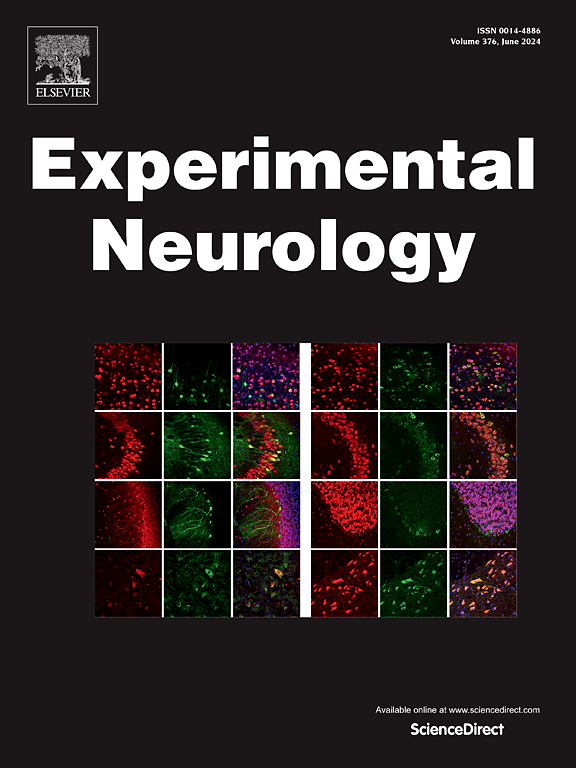肌萎缩性脊髓侧索硬化症的两个主要特征,即 STMN2 减少和致病性 TDP-43 协同作用,加速了小鼠运动能力的衰退。
IF 4.6
2区 医学
Q1 NEUROSCIENCES
引用次数: 0
摘要
几乎所有肌萎缩性脊髓侧索硬化症患者和半数额颞叶痴呆症患者都会出现TDP-43从细胞核中脱落和细胞质聚集的病理现象。Stathmin2(Stmn2)是TDP-43调控的一个关键靶点,在渐冻症、额颞叶痴呆症和阿尔茨海默氏病患者中发现了异常剪接的Stmn2 mRNA。STMN2 参与轴突损伤反应,其体内缺失可部分复制 ALS 类症状,包括进行性运动障碍和远端 NMJ 神经支配。由于 TDP-43 可调控人类而非小鼠 Stmn2 的剪接,因此尚未在小鼠中研究 STMN2 缺失与 TDP-43 功能障碍之间的相互作用。因此,我们产生了缺乏一个功能性 Stmn2 拷贝并表达一个突变 TDP-43Q331K 敲入等位基因的反式杂合小鼠,以研究 STMN2 功能的降低是否会加剧 TDP-43 依赖性病理。事实上,我们观察到了这两个等位基因之间的协同作用,导致了早期发病的渐进性运动障碍。令人惊讶的是,这种行为缺陷并不伴随大脑、脊髓、周围神经或神经肌肉接头(NMJs)中可检测到的神经病理变化。但是,反式杂合子小鼠的远端轴突和 NMJs 的线粒体形态异常。由于 STMN2 和 TDP-43 都会影响线粒体的动力学,而神经元线粒体功能障碍是许多神经退行性疾病的主要特征,因此这种异常很可能是导致所观察到的运动障碍的原因之一。这些研究结果表明,STMN2的部分缺失会显著加剧TDP-43相关表型,这表明恢复STMN2可以在变性开始之前改善TDP-43相关疾病。本文章由计算机程序翻译,如有差异,请以英文原文为准。
Two cardinal features of ALS, reduced STMN2 and pathogenic TDP-43, synergize to accelerate motor decline in mice
Pathological TDP-43 loss from the nucleus and cytoplasmic aggregation occurs in almost all cases of ALS and half of frontotemporal dementia patients. Stathmin2 (Stmn2) is a key target of TDP-43 regulation and aberrantly spliced Stmn2 mRNA is found in patients with ALS, frontotemporal dementia, and Alzheimer's Disease. STMN2 participates in the axon injury response and its depletion in vivo partially replicates ALS-like symptoms including progressive motor deficits and distal NMJ denervation. The interaction between STMN2 loss and TDP-43 dysfunction has not been studied in mice because TDP-43 regulates human but not murine Stmn2 splicing. Therefore, we generated trans-heterozygous mice that lack one functional copy of Stmn2 and express one mutant TDP-43Q331K knock-in allele to investigate whether reduced STMN2 function exacerbates TDP-43-dependent pathology. Indeed, we observe synergy between these two alleles, resulting in an early onset, progressive motor deficit. Surprisingly, this behavioral defect is not accompanied by detectable neuropathology in the brain, spinal cord, peripheral nerves or at neuromuscular junctions (NMJs). However, the trans-heterozygous mice exhibit abnormal mitochondrial morphology in their distal axons and NMJs. As both STMN2 and TDP-43 affect mitochondrial dynamics, and neuronal mitochondrial dysfunction is a cardinal feature of many neurodegenerative diseases, this abnormality likely contributes to the observed motor deficit. These findings demonstrate that partial loss of STMN2 significantly exacerbates TDP-43-associated phenotypes, suggesting that STMN2 restoration could ameliorate TDP-43 related disease before the onset of degeneration.
求助全文
通过发布文献求助,成功后即可免费获取论文全文。
去求助
来源期刊

Experimental Neurology
医学-神经科学
CiteScore
10.10
自引率
3.80%
发文量
258
审稿时长
42 days
期刊介绍:
Experimental Neurology, a Journal of Neuroscience Research, publishes original research in neuroscience with a particular emphasis on novel findings in neural development, regeneration, plasticity and transplantation. The journal has focused on research concerning basic mechanisms underlying neurological disorders.
 求助内容:
求助内容: 应助结果提醒方式:
应助结果提醒方式:


